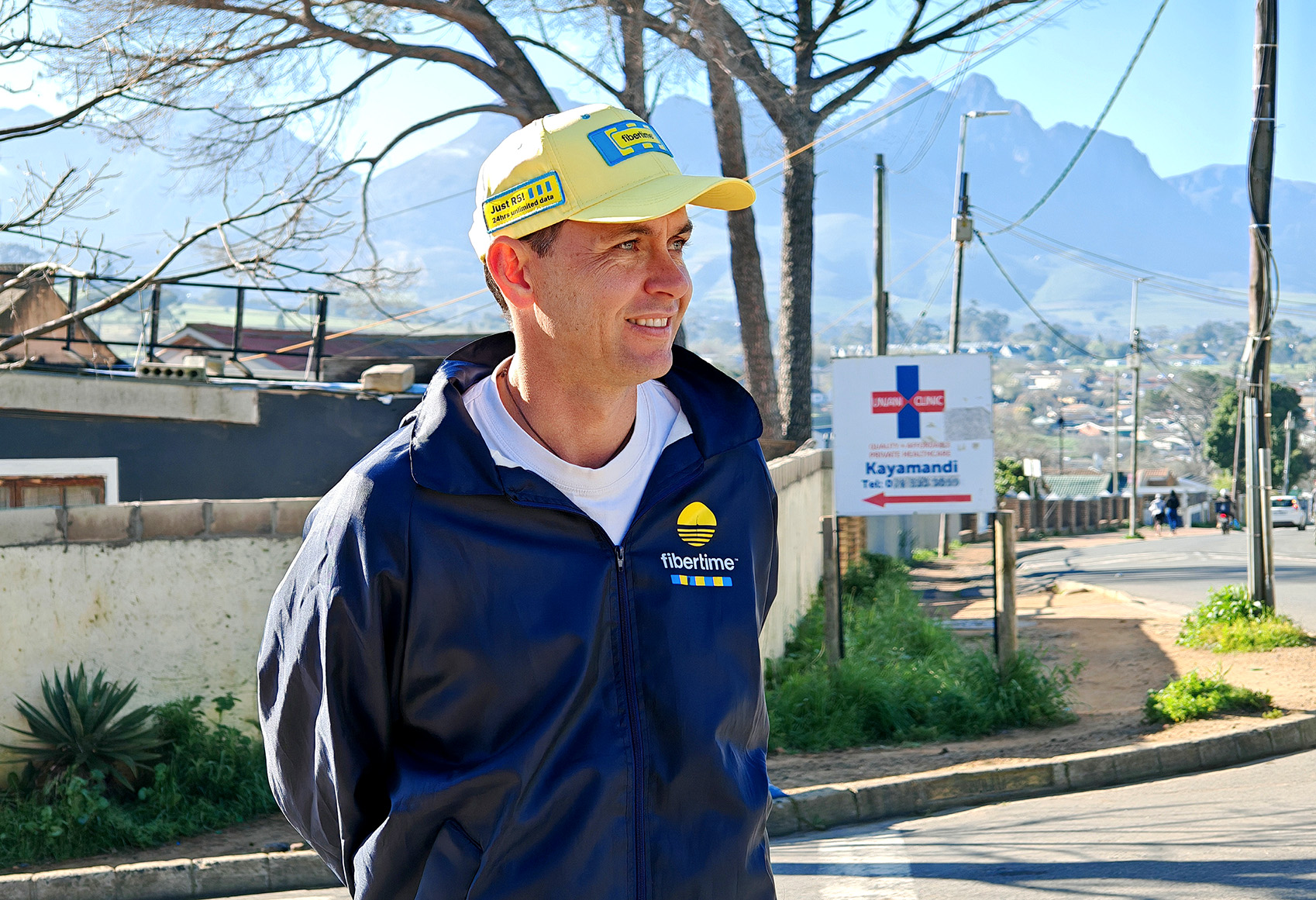My host disappeared around a corner while I stopped to take pictures and I heard the sound of footsteps approaching in the tiny walkway maze between dense Kayamandi township shacks. “I guess this is how it ends,” were my last, scared thoughts before turning to face my would-be assailant…
It turned out to be our security shadow – a woman from the community who I didn’t notice tailing us earlier. She’s wearing the beautiful bright yellow and blue colours of Fibertime.
I greet her politely while my heart migrates back to my chest.
The weight of expectation
“I always wanted to work for Vodacom, but not under my father because he is a very tough operator” says Alan Knott-Craig (he dropped the Jnr years ago) about his roots in the South African telecoms industry. He’s gesturing and speaking with the easy confidence of a man who has made – and lost – fortunes and is now chasing something he insists is bigger than money.
/file/dailymaverick/wp-content/uploads/2025/08/IMG_20250813_094610.jpg)
“I want to live in South Africa for the rest of my life. I want my kids to live here. But I don’t know if it’s sustainable to have this inequality. And it starts with access to opportunity.”
It’s not the first time Knott-Craig has been near the centre of a South African telecoms inflection point. His father started Vodacom. This walking tour of a working township happens just weeks after the Competition Appeal Court heard from Vodacom and Vumatel parent Maziv over their planned merger – a deal partly justified by Maziv’s claim that it couldn’t afford to finish rolling out township fibre without Vodacom’s money.
width="560" height="315" frameborder="0" allowfullscreen="allowfullscreen">
Township rules
One of the merger concessions now on the table is that the merged giant will have to pass over a million homes and connect every school it passes. Knott-Craig is betting his own business – Fibertime – can wire up every home, not just the easy ones, and do it without a blue-chip partner or government grant.
/file/dailymaverick/wp-content/uploads/2025/08/IMG_20250813_094530_1.jpg)
“If you’re saying it’s okay to do wireless in townships, you’re saying it’s okay for poor people to have *expletive* internet,” he says, ducking under a washing line strung between two shacks. “Even Elon Musk knows that, that’s why he doesn’t go to congested places like Lagos. The richest people in the world have fibre, so should they (townships).”
He’s built a pay-as-you-go model: R5 a day for 100Mbps (minimum) fibre-to-the-home. No throttling, no caps, no contracts. And no asking customers to commit a lump sum at the start of the month when an emergency could wipe out that budget by day 10.
/file/dailymaverick/wp-content/uploads/2025/08/IMG_20250813_095222.jpg)
Each device needs its own voucher – one per phone, one per laptop – and the network runs during load shedding, thanks to a UPS unit tied to every router (it’s the same Gizzu model I use to keep my routers going at home).
Crypto utility
He talks about blockchain billing as being the efficiency unlock. Vouchers are pegged to time – “a stablecoin”, he calls it – not data. “Minutes can’t be inflated,” he says. “If South Africa hits hyperinflation, you can swap your rand into Fibertime. You can still connect to the internet tomorrow, wherever you can connect to a Fibertime router.”
The morning is part sales pitch, part sociology lecture. In Knott-Craig’s telling, fibre is a lever against structural inequality, the kind he saw in 2010 when his two-year-old daughter was on an iPad while, down the road, 10 times as many kids had no books, no decent schools and no internet.
Walking these streets, it’s easy to see why he believes high density is a business advantage. In a leafy suburb, a hectare might hold 100 people. Here, it’s 10,000. That’s more customers per pole, more vouchers sold, more network “sweated” for profit. “It’s the volumes that drive the profit,” he says.
/file/dailymaverick/wp-content/uploads/2025/08/IMG_20250813_094452.jpg)
/file/dailymaverick/wp-content/uploads/2025/08/IMG_20250813_094224.jpg)
Playing nice with the locals
But it’s also a community play. He insists on hiring local labour and working through church and school leaders. “If you’re not part of the community, there’s an immune system that will expel you – violently if they think you’re just here to take advantage.
“We get the women of the community to escort us on site visits, they know everyone and can spot when something is about to go wrong – they intervene before it does.”
Read more: How Vodacom and Maziv convinced everyone they had changed
His team is connecting 1,200 households a day, in 30 townships across six cities. The goal: 400,000 households by April 2026, eight million by 2028.
Knott-Craig says he’s not waiting for SA Connect or a court to force the work. He’s building without subsidies, without merger conditions, without legacy baggage.
“Telecoms is really about customer service,” he says. “When you go into a community, they already got fibre, you just say, ‘It’s fibre time’. And they’ll take it tomorrow because they know it’ll be better.” DM




 Alan Knott-Craig speaks like a man who has been through a lot, entrepreneurship has worn on him. (Photo: Lindsey Schutters)
Alan Knott-Craig speaks like a man who has been through a lot, entrepreneurship has worn on him. (Photo: Lindsey Schutters)